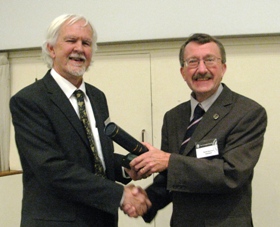 Martin Brasier was one the UK’s leading palaeobiologists. He was highly regarded for his research of the biosphere at key junctures in early Earth history, from the origin of Archaean life, to the emergence of multi-celled animals during the Cambrian explosion. Martin was Emeritus Professor of Palaeobiology, Department of Earth Sciences, University of Oxford, from where he had retired at the end of the previous academic year. He tragically died in a car accident on 16 December 2014.
Martin Brasier was one the UK’s leading palaeobiologists. He was highly regarded for his research of the biosphere at key junctures in early Earth history, from the origin of Archaean life, to the emergence of multi-celled animals during the Cambrian explosion. Martin was Emeritus Professor of Palaeobiology, Department of Earth Sciences, University of Oxford, from where he had retired at the end of the previous academic year. He tragically died in a car accident on 16 December 2014.
Born on 12 April 1947 he pursued his first degree at Chelsea College London, and was awarded his PhD from University College London in 1973, studying the ecology and microhabitats of modern benthic foraminifera of the Caribbean. Following brief employment with the BGS and a lectureship at the University of Reading, he moved to Hull, developing an interest in the taphonomy and diversity of lower Cambrian small shelly fossils.
In the early 1980s, with Hull colleague John Neale, he established a Masters Course in micropalaeontology. This coincided with the publication of his book, Microfossils, a second edition, with co-author Howard Armstrong (2004). His study of foraminiferal architecture and evolution was published in a special publication (1982) honoring the work of Tom Barnard, Martin’s PhD supervisor.
During the 1970s Martin contributed to the British Micropalaeontological Society (now The Micropalaeontological Society), serving as Foraminifera Group Secretary (1974-77), BMS Newsletter Editor (1977-79) and Foraminifera Group Chair (1983-85). In 1981 he was co-editor (with John Neale) of the book Microfossils from Recent and Fossil Shelf Seas, which detailed contemporary British micropalaeontological research, the format for this book was adopted by the BMS for its subsequent occasional publications.
Martin moved to Oxford in 1988, was elected a Fellow of St Edmund Hall, and helped establish a dedicated palaeobiology research laboratory. He pursued high-resolution contextual analysis of Ediacaran and Cambrian evolutionary radiations, and took a leading role in the International Geological Correlation Programme (IGCP), visiting Cambrian and Ediacaran stratotype sections used in the formal definition of these time periods.
During the next 15 years Martin helped revolutionise the study of the earliest biosphere, pioneering a new, critical approach in assessing the biogenicity of Earth’s most ancient traces of life. In April 2002 at the NASA Ames conference in San Francisco he debated the origins of the 3,460 MYr putative microfossils from the Apex chert deposit of Western Australia. Martin championed the approach of careful mapping at various scales, utilising features and fabrics from field observations and petrographic sections in interpreting the micro-fabrics – an approach that yielded a high scientific return in publications, and which he frequently referred to as his most satisfying research project.
Martin’s ability for storytelling was put to great effect in his popular science books Darwin’s Lost World (2009) and Secret Chambers (2013), bringing the Precambrian to life for a new and diverse audience. In early 2014 Martin’s contributions to geology were formally recognised by the award of the Geological Society of London’s prestigious Lyell Medal (picture), of which he was justifiably proud. Later in the year, on the occasion of his retirement a day of talks in the department was followed by a dinner at St Edmund Hall. The diversity of attendees indicated the wide influence that Martin had across the geological community, and the warmth with which he was regarded.
Martin has left us with a substantial scientific legacy of over 200 published papers and books. However, this would overlook his other diverse talents and interests. He was a skilled jazz pianist, and built some of his own keyboard instruments. He was a family man and is survived by his wife of more than 40 years Cecilia, sons Matthew and Alexander, daughter Zoe and two grandchildren.
Owen Green